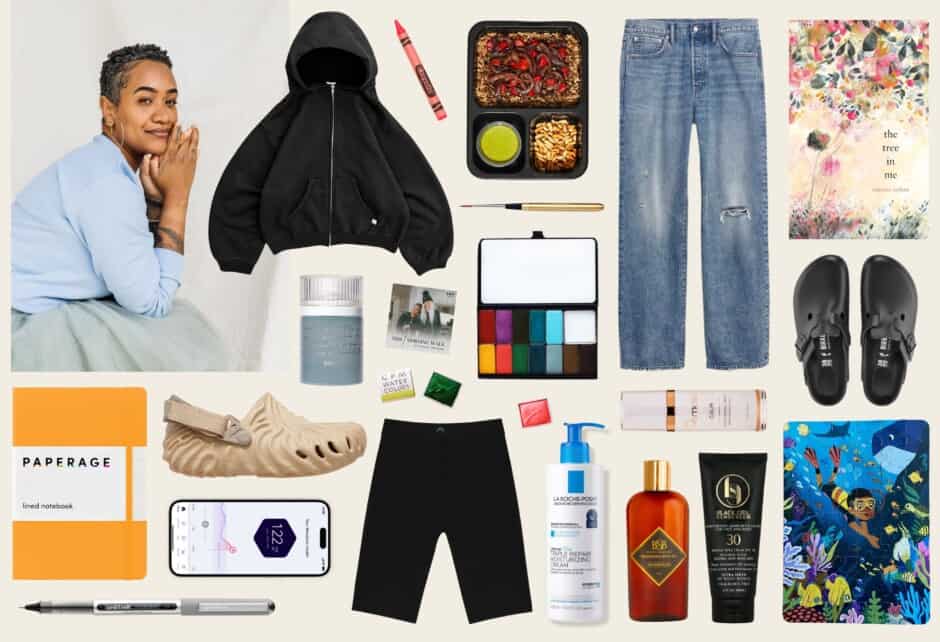
How To Talk To Your Kids About White Privilege
Written by WRITTEN BY MIA QUAGLIARELLO
Photography by Photographed by Michelle Drewes
“What side of history will you stand on?” That is the powerful question Jardana Peacock’s teachers asked her as early as grade school, when she began to get a deeper sense of what it really means to be white in America. “Essentially, I began to understand that as a white person I can be complicit in upholding systems of oppression,” she recalls. “Countering that requires deep spiritual work, an unlearning of history, behavior, and even thinking. It’s an ongoing journey that continues when you’re raising kids.”
Now that they have children, Peacock and her partner, activist and author Chris Crass, are in the throes of tackling these big themes with their little ones, while also speaking out against racial injustice through workshops, writing, and grassroots efforts. They let us in on their thinking, techniques, and resources for raising conscious kids, below.
How do you define white privilege?
Chris: “White privilege developed over the hundreds of years that the U.S. was a slave society. Laws had to be made to prevent Europeans, Africans, and Indigenous people from marrying, forming family, building friendships, forming bonds of love and solidarity. Denying people of color rights and opportunities for economic advancement, while granting rights and economic opportunities to Europeans was a way to create a structurally unequal racial hierarchy of Black and white and those who wanted to concentrate wealth and power to the few, used racism, racial antagonism, and racial divisions as a way to both create and maintain vast political and economic inequality.”
“White privilege is a very real material benefit for most white people. The police are in fact there to protect and serve you; your name and ancestry help you get a job; your family has had access to lower interest loans to buy housing in white-only suburbs; the color of your skin makes you appear more innocent; being white means you don’t have to think about race, the history of racial oppression and racial inequality, and how this history shapes the world around you and impacts your daily decisions and future experiences.”
“White privilege is a system of benefits for white people and a system of denial of those benefits to people of color. It is a strategy of dividing the vast majority of us from uniting for economic justice and building an inclusive, multiracial democracy where human rights and dignity for all are at the center rather than a worldview that justifies and maintains devastating poverty in communities of color and in white communities—while the 1% has more wealth than the combined wealth of 80% of us from the bottom up.”
“How I talk about white privilege does change depending on whom I’m talking with. I try to think about what will resonate with the person. Just like as parents, we have to think about what helps our kids and different things work with different people: some are moved by poetry, others through personal stories, and others through joining a community protest against police violence against young Black people.”
What age is appropriate to start discussing things like racial justice and white privilege, and how should the discussion change as the child gets older?
Jardana: “I’ve found that children are very open and aware, as I’m sure many parents discover early on. For Chris and I, these conversations are at the very core of how we build our family culture, what we stand for, and what we hope our children will stand for. The conversations are messy. I don’t think there is a formula because every child is different and every moment is different. The site Raising Race Conscious Children is an excellent resource.”
“We’ve pretty much talked about racism and other systems of oppression since the beginning. You just kind of try it out based on their comprehension level. When we talked with River as a young child, it was often, ‘So many of our friends are being killed because they are Black. Black Lives Matter to our family.’ As a 3-year-old I’m not sure he fully grasped the full meaning of what we were saying, but the foundations had been laid. Our library of kids’ books includes ones about the children’s march of the Civil Rights movement in Birmingham in 1963, when kids in middle and high school marched for integration and against racism, and other books with young characters who’ve made bold choices in the face of violence and oppression.”
“Our kids can relate and see themselves in these stories. We’ve also taken our kids to a lot of social justice rallies, meetings, and demonstrations and built deep relationships across differences. Our kids experience the world we are working to build in the future. This helps them imagine a different way and gives them permission to enact a different reality.”
“It extends beyond reflecting our values in the toys, books, and activities they are engaged with (which also includes tons of imaginative play, art, and the natural world), but to also include them and their voices in the process. Our oldest, River, spoke at a school board meeting, as a kindergartener, asking them to make Louisville schools sanctuary schools for refugees and immigrant youth. For him, that was his choice and he wanted to speak out because he’s a very outgoing kid and because his friend Jafar is Muslim and he felt that issue on a very personal level.”
What kinds of emotions can a parent expect to come up around this topic—in themselves and in their child?
Jardana: “The biggest emotion that comes up is fear. Fear that you will make a mistake or traumatize your children with the very devastating facts of racism. I guess I would offer this: we all make mistakes. There is no formula for this. We are making this better world we all want, as we go. I think it’s so important to be transparent with kids and with other adults. I am constantly admitting to my mistakes, and sharing with folks my feelings of doubt and shame that arise within me as these feelings arise. This has helped me break through perfectionist tendencies, which are very rooted in a white supremacy culture that divides us from each other instead of linking us to each other.”
“I am asking myself constantly—how am I building a culture within my family and with my kids that reflects my deep-rooted values? For example, I believe in transgender, LGBTQI, and genderqueer rights. For me it has been vital to challenge binaries that ask us to choose between a certain presentation of male and female. That means that we buy our boys dolls and dresses, along with cars and pants. That means we engage in conversations with our kids and other kids if they declare, ‘This is a ‘girl’ thing.’ We talk about gender expression and equality in how we live. It’s not just an adult topic; it’s the reality of all of our kids.”
If a child or family wants to speak out or change the status quo, how can they do that?
Chris: “We are living in historic times, with the Trump White House working to advance a racist agenda against public education, against immigrants, against Muslims, and against working people of all colors, alongside the escalating violence of neo-Nazis, the Klan, and everyday racists, we are living at a time in which there is a fight for the soul of white America. At the same time, there are powerful multiracial social justice movements to get involved in online or in our local communities.”
“Online you can join Moms Rising. To join a community of parents committed to creating anti-racist families, check out Embrace Race. Locally, look for community events and demonstrations for racial justice, and for white people, join a local chapter of Showing Up for Racial Justice (SURJ), which is a national network organizing white people for racial justice. SURJ also has a great online community for white parents who want to take action for racial justice and bring anti-racism into their families.”
“Challenging the status quo and working for change can also be as simple as letting conversations with your kids emerge, rather than suppressing them. I’ve had lots of white parents say that they felt ashamed or worried when their young child talked about the color of other kids’ skin at school or the playground. Some white parents respond with ‘Don’t say that, it’s rude,’ which sends the message that you’re not supposed to talk about racism, which is the status quo of white silence. Or they’ll say, ‘We’re all the same, color doesn’t matter’ and perpetuate the idea that race doesn’t matter. Studies show that kids begin noticing differential treatment based on skin color when they’re 4 and 5 years old. Too often white parents are shutting down conversations about race which leaves white children racially illiterate in a society deeply shaped by racial inequality. Then the loudest most consistent voices in white communities are racists, and they fill the void of liberal/progressive white silence.”
“The best thing we can do is show up for racial justice in intimate conversations and moments in our family and show up in our community. When we go to rallies, I try to help explain to my kids what’s going on, in small doses, before they say ‘Stop it, dad.’ I’ll name leaders in our community as they speak and if they are part of our family and community, I’ll remind the kids of that. And I’ll try to bring the kids over to meet people and introduce them. I want my kids to be literate about liberation values and also know that liberation leaders are all around us in our family and everyday life. I want my kids to grow up with an understanding of what leadership for liberation looks like, and support to become leaders themselves.”
“The main thing is show up, get awkward, and remember that ultimately, this is about all of us getting free from the nightmare of racism.”
Further Resources To Explore:
Raising White Kids: Bringing Up Children in a Racially Unjust America by Jennifer Harvey
Between the World and Me by Ta-Nehisi Coates
Raising Race Conscious Children
Why Are All the Black Kids Sitting Together in the Cafeteria: And Other Conversations About Race by Beverly Daniel Tatum
Waking Up White and Finding Myself in the Story of Race by Debby Irving
Practice Showing Up: A Practice Guide for White People Working For Racial Justice by Jardana Peacock
Towards the “Other America”: Anti-Racist Resources for White People Taking Action for Black Lives Matter by Chris Crass
From Mother:
18 Kids Books About Gender That Challenge Norms
How To Challenge Gender Stereotypes In The Media Your Kids Consume
Mother Stories: Jodie Patterson
Share this story



